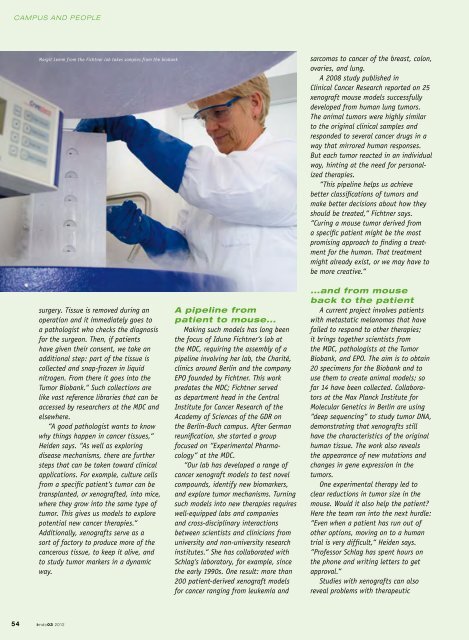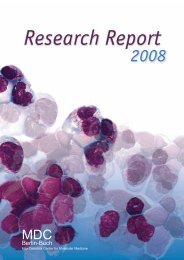iMDC03 zum Download (pdf)
iMDC03 zum Download (pdf)
iMDC03 zum Download (pdf)
Erfolgreiche ePaper selbst erstellen
Machen Sie aus Ihren PDF Publikationen ein blätterbares Flipbook mit unserer einzigartigen Google optimierten e-Paper Software.
CaMpus anD people<br />
Margit Lemm from the Fichtner lab takes samples from the biobank<br />
surgery. Tissue is removed during an<br />
operation and it immediately goes to<br />
a pathologist who checks the diagnosis<br />
for the surgeon. Then, if patients<br />
have given their consent, we take an<br />
additional step: part of the tissue is<br />
collected and snap-frozen in liquid<br />
nitrogen. From there it goes into the<br />
Tumor Biobank.“ Such collections are<br />
like vast reference libraries that can be<br />
accessed by researchers at the MDC and<br />
elsewhere.<br />
“A good pathologist wants to know<br />
why things happen in cancer tissues,“<br />
Heiden says. “As well as exploring<br />
disease mechanisms, there are further<br />
steps that can be taken toward clinical<br />
applications. For example, culture cells<br />
from a specific patient‘s tumor can be<br />
transplanted, or xenografted, into mice,<br />
where they grow into the same type of<br />
tumor. This gives us models to explore<br />
potential new cancer therapies.“<br />
Additionally, xenografts serve as a<br />
sort of factory to produce more of the<br />
cancerous tissue, to keep it alive, and<br />
to study tumor markers in a dynamic<br />
way.<br />
54 imdc03 2012<br />
a pipeline from<br />
patient to mouse...<br />
Making such models has long been<br />
the focus of Iduna Fichtner‘s lab at<br />
the MDC, requiring the assembly of a<br />
pipeline involving her lab, the Charité,<br />
clinics around Berlin and the company<br />
EPO founded by Fichtner. This work<br />
predates the MDC; Fichtner served<br />
as department head in the Central<br />
Institute for Cancer Research of the<br />
Academy of Sciences of the GDR on<br />
the Berlin-Buch campus. After German<br />
reunification, she started a group<br />
focused on “Experimental Pharmacology“<br />
at the MDC.<br />
“Our lab has developed a range of<br />
cancer xenograft models to test novel<br />
compounds, identify new biomarkers,<br />
and explore tumor mechanisms. Turning<br />
such models into new therapies requires<br />
well-equipped labs and companies<br />
and cross-disciplinary interactions<br />
between scientists and clinicians from<br />
university and non-university research<br />
institutes.“ She has collaborated with<br />
Schlag‘s laboratory, for example, since<br />
the early 1990s. One result: more than<br />
200 patient-derived xenograft models<br />
for cancer ranging from leukemia and<br />
sarcomas to cancer of the breast, colon,<br />
ovaries, and lung.<br />
A 2008 study published in<br />
Clinical Cancer Research reported on 25<br />
xenograft mouse models successfully<br />
developed from human lung tumors.<br />
The animal tumors were highly similar<br />
to the original clinical samples and<br />
responded to several cancer drugs in a<br />
way that mirrored human responses.<br />
But each tumor reacted in an individual<br />
way, hinting at the need for personalized<br />
therapies.<br />
“This pipeline helps us achieve<br />
better classifications of tumors and<br />
make better decisions about how they<br />
should be treated,“ Fichtner says.<br />
“Curing a mouse tumor derived from<br />
a specific patient might be the most<br />
promising approach to finding a treatment<br />
for the human. That treatment<br />
might already exist, or we may have to<br />
be more creative.“<br />
...and from mouse<br />
back to the patient<br />
A current project involves patients<br />
with metastatic melanomas that have<br />
failed to respond to other therapies;<br />
it brings together scientists from<br />
the MDC, pathologists at the Tumor<br />
Biobank, and EPO. The aim is to obtain<br />
20 specimens for the Biobank and to<br />
use them to create animal models; so<br />
far 14 have been collected. Collaborators<br />
at the Max Planck Institute for<br />
Molecular Genetics in Berlin are using<br />
“deep sequencing“ to study tumor DNA,<br />
demonstrating that xenografts still<br />
have the characteristics of the original<br />
human tissue. The work also reveals<br />
the appearance of new mutations and<br />
changes in gene expression in the<br />
tumors.<br />
One experimental therapy led to<br />
clear reductions in tumor size in the<br />
mouse. Would it also help the patient?<br />
Here the team ran into the next hurdle:<br />
“Even when a patient has run out of<br />
other options, moving on to a human<br />
trial is very difficult,“ Heiden says.<br />
“Professor Schlag has spent hours on<br />
the phone and writing letters to get<br />
approval.“<br />
Studies with xenografts can also<br />
reveal problems with therapeutic
















